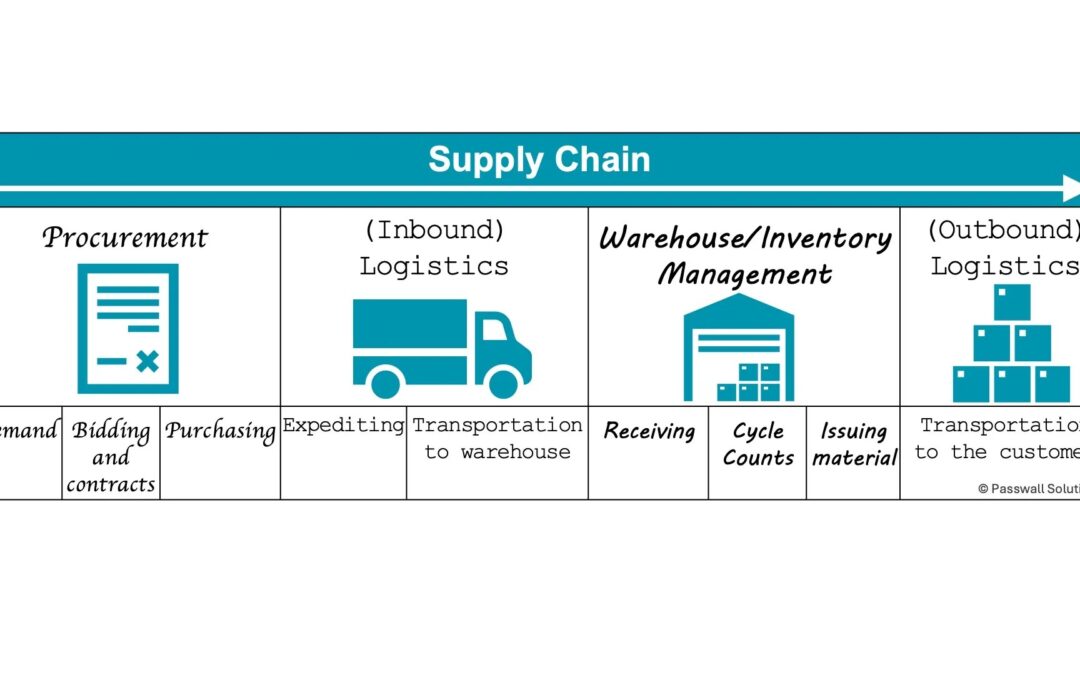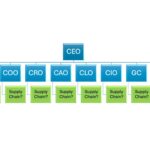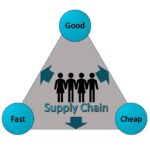What is the difference between “supply chain” and “procurement”? One of my favorite silver linings after COVID is that when people ask me what I do, I now answer “Supply chain” and they reply, “You’re the people who get us toilet paper!” Or sometimes I can see them simply thinking it. Yes, we get you toilet paper and electricity and HR benefits and a myriad of other things that make up modern life. But what about procurement? Or logistics? Or warehouses? How do they fit into a supply chain, and what are the differences between supply chain and those aspects of getting goods and services at the right price, time and quality?
Supply Chain
My definition of “supply chain” covers the full supply chain process from demand to delivery to the final customer. The three main categories I consider in the supply chain are procurement, logistics, and warehouse or inventory management. For companies with complicated outbound logistic networks, logistics would cover the final delivery from the warehouse to the external customer. Let’s dive a little deeper into each aspect of the full supply chain.
Procurement
The supply chain process starts with Procurement. Especially in companies without major logistics departments (such as utilities), the term “Procurement” is used interchangeably with “Supply Chain.” Of course, they are not at all the same. Procurement starts with managing demand, from either external or internal customers. This might include Sales, Inventory, and Operations Planning (SIOP), or that function might live in operations and pass information to the procurement team. Either way, the entire supply chain starts when triggered by a need.
Depending on the size of the need, the procurement team will bid and contract to fulfill that demand. This includes working with internal customers to write a good scope of work and thinking about the best way to strategically source the material or service. In the background before and after any specific demands, the procurement team is analyzing spend, conducting business and supply planning, and keeping an eye on the motion of key categories on the global market. In my definition of Supply Chain, the purchasing function is part of the procurement function.
Purchasing
When companies do not interchange “Supply Chain” and “Procurement”, they often interchange one or the other of those terms and “Purchasing.” I personally like to see a company use Procurement for their departments and job titles as it is a more strategic function and wider-reaching than Purchasing. Purchasing is a very transactional component of procurement, and includes quoting, cutting purchase orders, and may include expediting. Quoting is different from bidding, as quotes are small and generally gathered through email. Bids include a scope of work and hopefully a contract or other long-term agreement, and may be gathered with an online bidding software such as Coupa, Ariba or MarketDojo.
Cutting purchase orders dominates the purchasing function. When businesses have a purchasing department, that is generally the place where professionals use an Enterprise Resource Planning (ERP) system to convert requisitions or other requests into purchase orders and issue them to suppliers. This function in a supply chain is most susceptible to AI and automation as technology continually shifts and spurs change in the supply chain space.
Logistics
The logistics component of a supply chain happens between order and delivery to company warehouses/sites. In the strictest definition, I include expediting orders in the logistics space, although sometimes this rests with the purchasing function. The reason to leave it in the purchasing function is to drive accountability in the people cutting purchase orders and ensure they “own” the order until it is safely delivered. The reason to include expediting in logistics is to ensure the people who understand needed delivery timing can orchestrate that timing precisely. Often companies without in-house logistics teams will have suppliers handle all inbound logistics. While this is easier and saves internal labor, it is also more costly, increases shipping partial truck loads instead of full truck loads, and results in fewer route efficiencies.
For a service, there is still a logistics component in ensuring the service is delivered to the relevant company department. For delivery of an electronic service, the IT department may even serve as the “logistics” team through ensuring delivery of large files using an FTP site or other secure delivery method.
Warehouse/Inventory Management
The warehousing function is an important one for a company selling materials, and often erroneously separated from the larger supply chain team in the org chart. The warehouse function includes receiving materials, both physically and electronically, and managing that material once it arrives. Solid warehouse and inventory management includes cycle counts of inventory on hand to ensure system accuracy and using clean processes to issue out material and reduce obsolescence. It may also include working with the procurement team to reduce the right inventory to improve cash flow without material shortages.
Outbound Logistics
Businesses with an in-house logistics fleet or an outbound logistics partner may include the outbound logistics of finished goods in their supply chains. This includes ensuring materials flow to the end customer or retail center with minimal risk and maximum efficiency. The team that handles outbound logistics is likely to be connected to the inbound logistics team (if not overlapping) and are accomplished at tracking material as it moves through the transportation system.
Now that we’ve clarified the components of a supply chain, how do you see this playing out in your own business? Are the departments disjointed and reporting up through different executives, resulting in a fractured supply chain? Or are they harmonized to the point where your supply chain is almost invisible until there’s a major supply chain disruption?




